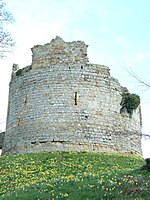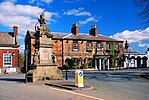Penymynydd
Clwyd geography stubsVillages in Flintshire

Penymynydd is a small village in Flintshire, Wales, merging with the larger neighbouring village of Penyffordd. The name Penymynydd is Welsh, meaning "top" or "end of the mountain". The village consists of a number of modern housing estates (Well House Drive, Coed Terfyn, Coed Y Graig), and also housing on Penymynydd Road (most of which is in Penyffordd). Penymynydd has one church: St John The Baptist's Church. A second church formerly existed in the village and has since been redeveloped. St John The Baptist's Primary School is church aided and takes children between the ages of 3 and 11.
Excerpt from the Wikipedia article Penymynydd (License: CC BY-SA 3.0, Authors, Images).Penymynydd
Mount Tabor Close,
Geographical coordinates (GPS) Address Nearby Places Show on map
Geographical coordinates (GPS)
| Latitude | Longitude |
|---|---|
| N 53.155 ° | E -3.04 ° |
Address
Mount Tabor Close
Mount Tabor Close
CH4 0YS , Penyffordd
Wales, United Kingdom
Open on Google Maps










